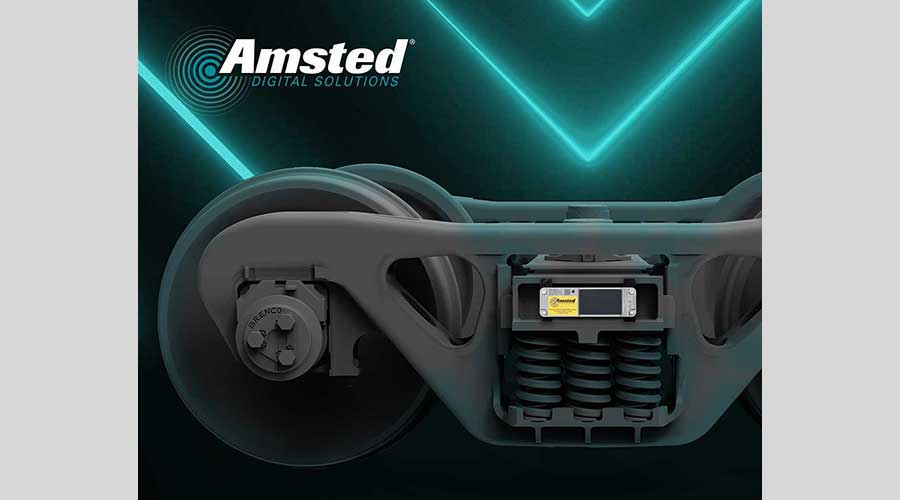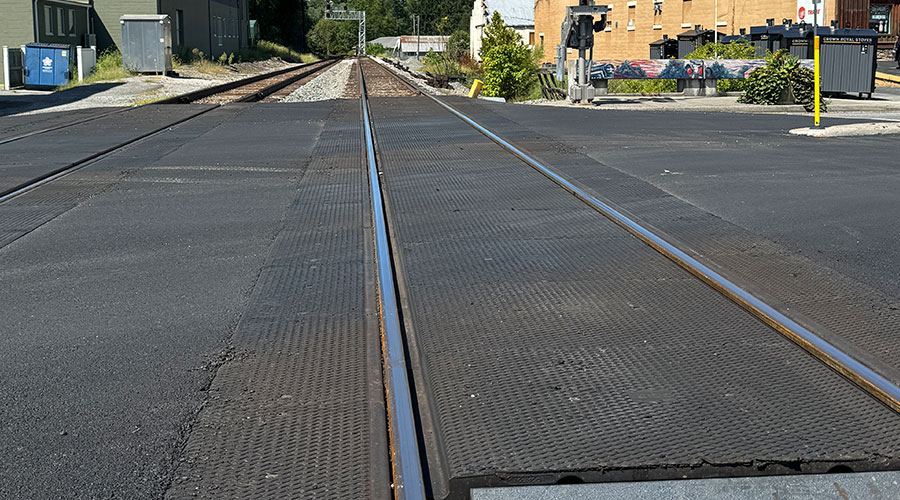Stay updated on news, articles and information for the rail industry
September 2007
Rail News: C&S
21st century data mining
By Walter Weart
In the not-too-distant past, a train crew would have received a message from a wayside detector, and the Automatic Equipment Identification (AEI) reader would have updated a database with passing and directional information. Not anymore, as the depth and breadth of data is increasing — and the future holds the promise of even more capabilities and possibilities. Railroads, shippers, repair shops, marine terminal operators and intermodal yard managers are mining more and more data — which they’re collecting from trackside and handheld readers, onboard locomotive devices and integrated systems — for an array of purposes.
“The first AEI reader went on line in 1989 and now, with the addition of GPS and ‘smart car’ technology, we will have even more event information available to us,” says Mike McClendon, AEI systems specialist for BNSF Railway Co.
The challenge? For users, it’s sorting all this newfound data, interpreting it and using it to get better at keeping freight moving. For technology providers, it’s keeping abreast of the needs of their increasingly diverse customer bases.
Trickle-down technology
In the rail realm, the AEI evolution has tricked into short-line and regional country: “We are finding that these carriers need better and more timely data not only for use with their connections, but for their shippers as well to enhance service,” says Andrew Friend, president of Application Technology by Design Inc. (ATBD), which provides AEI consulting services to short lines.
Witness Farmrail System Inc., which comprises two railroads in western Oklahoma. Farmrail’s train crews now are equipped with handheld devices enabling them to “scan AEI tags, then record whether they are picking up, setting out or doing other related activities,” says Judy Petry, Farmrail’s controller. The railroad can automatically report events to RMI, a transportation and logistics service provider.
“We gather data from the AEI reader and generate location data for our clients, which can be the railroad, shipper or car owner,” says RMI Vice President of Marketing Paul Pascutti.
Officials at the Iowa Interstate Railroad Ltd. also have turned to technology to improve event reporting — and, so, operating efficiency. The 550-mile regional plans to equip 32 of its 39 locomotives with Lat-Lon L.L.C. RailRider™ GPS Locomotive Monitoring Units (LMUs).
“These units can not only provide data about the speed, direction and engine run status, they also monitor fuel and overspeed impacts,” says Iowa Interstate Chief Transportation Officer Mick Burkhart, adding that locomotive location can be displayed graphically. “The LMU monitors fuel, and should a locomotive run out of fuel during freezing weather, the cost of repairing the engine would exceed the cost of the LMU.”
Lat-Lon also supplies systems designed to keep tabs on rail cars, containers and barges. As of August, about 2,000 rail cars were equipped with systems to monitor location, speed and impact detection, says Lat-Lon Partner Steve Tautz. Users access the data via the Internet.
“We have the ability to send an alarm when pre-specified events occur, which can be sent to pagers and cell phones to ensure the appropriate personnel can take immediate action,” Tautz says.
Meanwhile, Houston’s Port Terminal Railroad Association is working with RMI to utilize GPS technology installed on locomotives to “record actual placements by assigning each industry a ‘long-lat’ coordinate that will function as a pseudo reader,” says Andy Romer, the association’s director of system design. “We expect this to improve our industry event reporting by an additional 25 percent.”
The improvement can be felt rail-network-wide. For example, RMI sends information to Railinc Corp., an information technology services provider to North American railroads, shippers, equipment owners and suppliers. All North American railroads, as well as car owners, share the detector-generated data, which can lead to proactive preventative measures and reduce the so-called “stress state” of the rail industry.
Developed in 2004 to support the Association of American Railroads’ (AAR) Advanced Technology Safety Initiative, Railinc’s Equipment Health Management System (EHMS) is designed to facilitate the communication of alerts generated by wayside detectors, as well as provide a means to report equipment repairs and collect data on equipment repair history.
EHMS monitors alerts for both wheel impact load and truck hunting detectors; acoustic bearing detection will be added later this year, with other detector data coming in subsequent years, says Alan McDonald, Railinc’s director of equipment systems.
‘Total yard management’
The information technology evolution also is evident outside the rolling stock realm.
For example, APS Technology Group Inc. uses “AEI and high-resolution cameras combined with optical character recognition technology to capture the information from both in or outbound trains and supply this data to other software packages for total yard management,” says Matt Ramsey, director of business development.
A provider of Optical Character Recognition (OCR) systems and vision-based technology solutions for marine and intermodal terminals, APS also markets products designed to provide railroads more access to field information. The Rail OCR Portal and RailTrack systems use trackside AEI readers, high-resolution closed-circuit cameras and OCR software to identify, track and archive images and equipment numbers as trains enter a yard.
The Rail OCR Portal reads rail cars’ AEI tags and transmits the data to a central computer that records the equipment information. The portal then triggers the RailTrack system, which uses in-ground sensors and overhead cameras mounted on light poles to trace cars as they move through the yard. RailTrack continually updates the GPS coordinates of each car.
APS clients include the Alameda Corridor Transportation Authority, which is using the rail portal system on three mainline tracks to automatically identify rail-laden containers. The system will help the authority more quickly locate specific containers as part of its new High-Risk Cargo Container Tracking System. In 2005, APS obtained a contract to provide the Rail OCR Portal and RailTrack for APM Terminals’ Pier 400 facility in Los Angeles. The aim: help the terminal identify rail-car-laden containers and track their GPS location on the terminal’s 12 on-dock rail tracks.
Technology providers also are offering solutions for repair shops, which have their own AEI needs. SSG Innovations L.L.C. developed a handheld unit to complement its ExpressYard™ rail-car repair billing system. Car-repair workers slide the wireless handheld device — used to collect car repair data — onto a pistol grip, point the gun at an AEI tag and pull the trigger to automatically collect car information. Then, a worker can slide the handheld off the pistol grip and complete the inspection.
“While we can currently alert the user that the car has a defect, we are rolling out the ability to identify the specific defect in more detail,” says Justin Gillam, a partner in (and director of sales for) SSG Innovations.
Rail customers want better data, too. Enter Industrial Networks Ltd. (INet), which provides RFID, AEI and barcode data acquisition systems for manufacturing and shipping operations.
INet’s wireless networks enable clients to “efficiently deploy portable and stationary scanners that monitor inbound and outbound rail cars, trucks and barges,” according to the company’s Web site. The aim? Provide customers with better control over field operations, reduce errors and improve productivity.
“We work with Bourque Data Systems Inc., using their database and our hardware through YardMaster Mobile® and YardMaster Monitor®, compiling rail-car data by reading the AEI tag on the rail car while the system verifies the direction of travel and records the exact location of rail cars — even with in-plant switch moves,” says INet President Jimmy Finster.
YardMaster Monitor is designed to handle all aspects of rail-car use — from inspection to loading or unloading to release of the cars. And INet’s Railtrac Monitor® and Railtrac Mobile® readers “report in the T-94 [data] format,” says Finster.
The more info, the better
The data mining development continues. Earlier this year, ATBD and Southern Technologies Corp. unveiled the release of the new SmartScan Model 2400 Portable AEI Reader, a handheld tag reader that incorporates the processing power of an iPAQ Personal Digital Assistant. The device reads, translates, displays and records all AAR-approved transportation tags, ATBD says on its Web site; an optional barcode reader also is available.
Meanwhile, Southern Technologies plans to market a handheld reader featuring software developed by Softrail. The reader “will provide an affordable yard inventory system,” says Paul Mench, president of Southern Technologies, which offers integrated defect detection and AEI systems for railroads in North and South Americas, Australia, Africa and Europe.
“By using a wireless network, the user can transmit yard data to a PC, which can then display the car inventory graphically in map format,” Mench says.
The application possibilities are endless. On its Web site, ATBD says it “has developed relationships within the alternative fuel manufacturing [sector] … to ensure this fast-growing industry is compatible with wayside data reporting.”
The more information — and more information sharing — the better.
“We need to move forward, applying standards to equipment and platforms, which will call for development [to occur] in stages to benefit all users,” says BNSF’s McClendon. 
— Walter Weart is a Denver-based free-lance writer.
Keywords
Browse articles on AEI automatic equipment identification data management BNSF Farmrail Application Technology by Design RMI Iowa Interstate Lat-Lon Port Terminal Railroad Association Railinc AAR APS Technology Group SSG Innovations Bourque Data Industrial Networks Ltd. Southern Technologies SoftrailContact Progressive Railroading editorial staff.


 2025 MOW Spending Report: Passenger-rail programs
2025 MOW Spending Report: Passenger-rail programs
 Gardner steps down as Amtrak CEO
Gardner steps down as Amtrak CEO
 Guest comment: Oliver Wyman’s David Hunt
Guest comment: Oliver Wyman’s David Hunt
 Women of Influence in Rail eBook
Women of Influence in Rail eBook
 railPrime
railPrime







